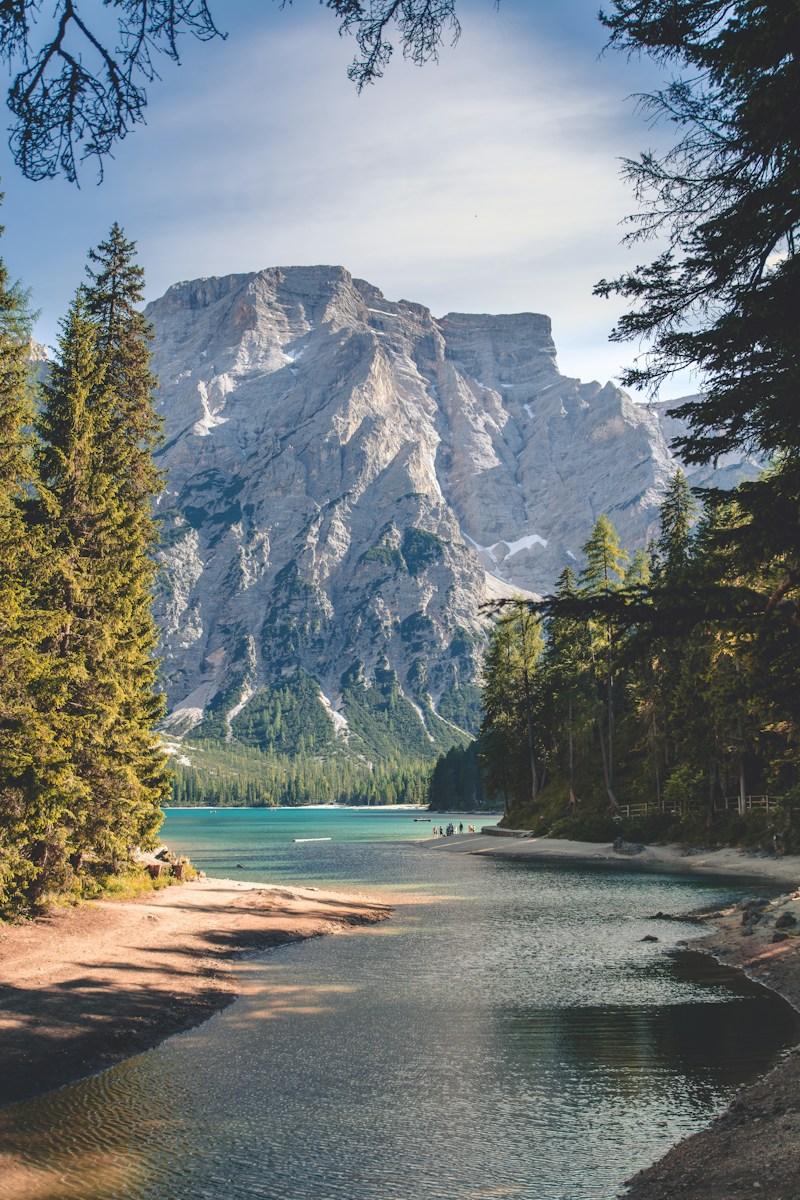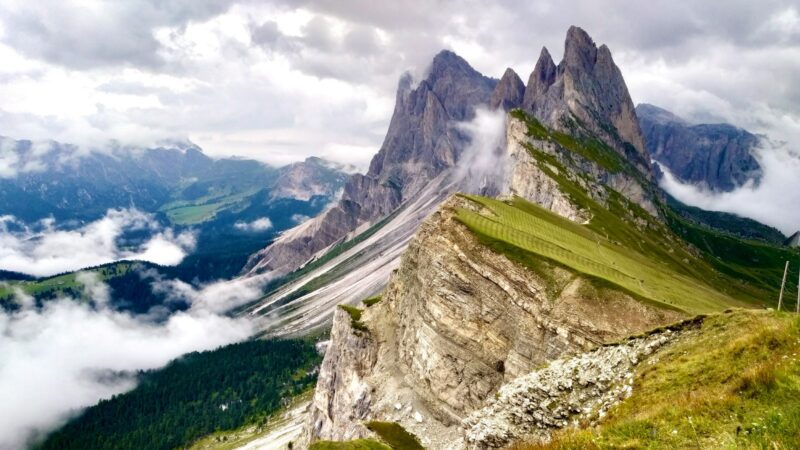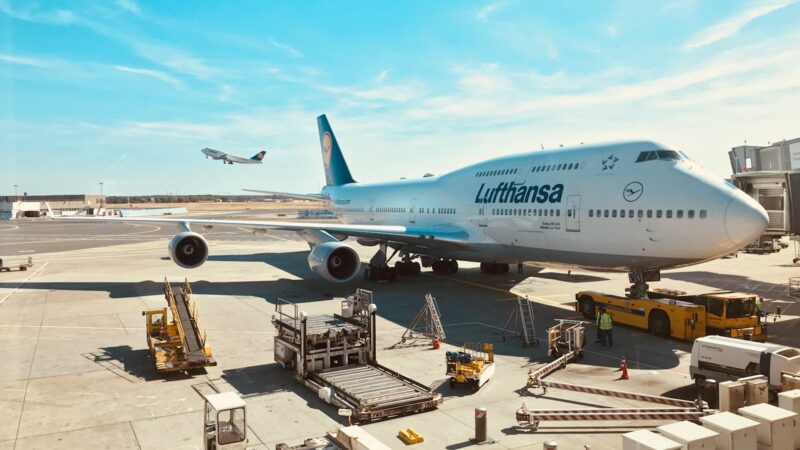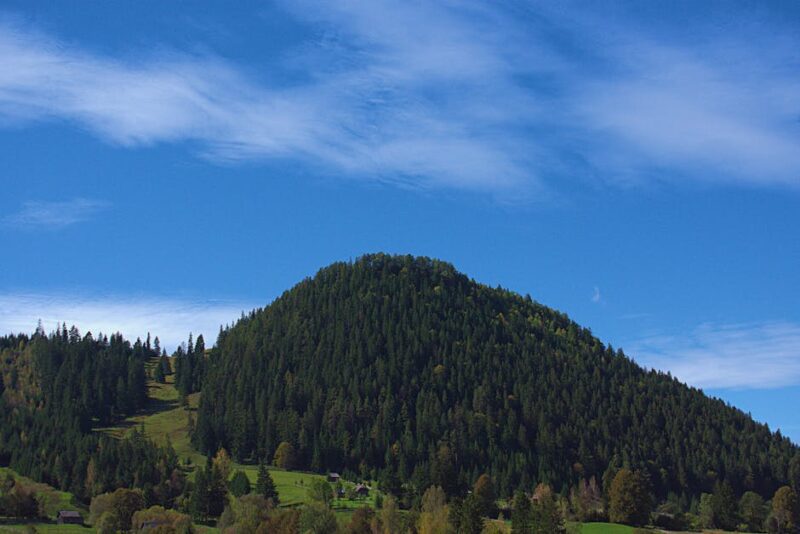Via ferrata, Italian for “Iron Route,” offers an invigorating blend of hiking and climbing, presenting a unique way to explore some of the world’s most stunning vertical terrains. These protected climbing routes are characterized by steel cables which climbers can secure themselves to, reducing the risk of falling. Additional features such as ladders, bridges, and metal steps assist adventurers in scaling steep cliff faces and towering mountain sides. Originating from the rocky facets of the Dolomites in Italy, where they were used during World War I, via ferratas have since become popular recreational routes that provide the thrill of mountain climbing to those without the technical skills required for rock climbing.
The Dolomites remain a premier destination for via ferrata enthusiasts, offering a historic backdrop and challenging routes that cater to a range of skill levels. However, the appeal of via ferratas has spread beyond Italy, attracting those seeking adrenaline and unparalleled views. From the ancient paths in the Italian ranges to the more recently developed routes across the globe, the world presents numerous opportunities for via ferrata exploration.
Outside of Europe, the growth of via ferratas continues in places like China, where the Chang Kong via ferrata presents an extreme challenge for adventurers. In the United States, although less common, the practice gains popularity with the remote and scenic routes offered in locations like Alaska. As each via ferrata has its unique features, surroundings, and levels of difficulty, they all share the common goal of making the mountains more accessible to the public, providing safe and engaging climbing experiences.
Table of Contents
ToggleHistory and Origin of Via Ferrata
The term “via ferrata” is Italian for “iron path,” and it refers to a climbing route that’s equipped with fixed anchors, such as cables, ladders, and bridges. These enhancements make the routes accessible to a wider range of climbers, allowing them to experience high mountain environments safely. The concept took hold largely due to military strategies employed during World War I in the Dolomites.
World War I Influence
During World War I, the mountainous terrain of the Dolomites posed significant challenges for soldiers who needed to navigate the area efficiently and securely. To solve this, Italy and the Austro-Hungarian forces installed fixed lines and ladders to move troops and supplies across the steep cliffs and ledges. These rudimentary via ferratas were functional, providing crucial mobility even under adverse conditions.
Italian Soldiers’ Legacy
After the war, these mountain routes were repurposed for recreational climbing. Italian soldiers’ ingenuity gave birth to the modern via ferrata, transforming the battlefield remnants into pathways for exploration and tourism. The maintenance and expansion of routes have been ongoing, with many historic routes restored and new ones added. In contemporary times, the Dolomites remain a premier destination for via ferrata enthusiasts, boasting some of the most iconic routes globally. The integration of rifugios, which are mountain huts offering lodging and meals, further supports climbers on their journeys through the Italian Alps.
Equipment and Safety
In via ferrata climbing, having the right equipment and adhering to safety protocols is paramount to a climber’s experience and survival. Here’s what one must know about the essential gear and safety protocols before embarking on a via ferrata adventure.
Essential Gear
- Cables and Ladders: Via ferrata routes are outfitted with steel cables and, at times, ladders to aid in climbing. These are fixed to the rock, providing the necessary support.
- Harness: A specially designed via ferrata harness is vital for protection; it allows climbers to attach themselves to the cable system securely.
- Carabiners: Specialized via ferrata carabiners, which lock automatically, connect the harness to the safety cable, reducing the risk during a fall.
- Helmet: Wearing a helmet is crucial as it protects the climber from head injuries from falling rocks or in case of a stumble.
Safety Protocols
- Regular Checks: Before starting, climbers must check their equipment for any damage or wear and ensure it meets safety standards.
- Correct Usage: It’s important that climbers are trained or briefed on the correct use of carabiners and the harness to maintain continuous attachment to the cable.
Best Via Ferrata Locations in Europe
Europe is renowned for its breathtaking via ferratas, with the Italian Dolomites, French Alps, and Swiss Mountains offering some of the most memorable climbing experiences. Here, enthusiasts find a blend of challenging routes, historic pathways, and stunning panoramas.
Italian Dolomites
The Dolomites in northeastern Italy present a legendary via ferrata experience deeply intertwined with the region’s history. Routes here cater to all levels, from beginners to advanced climbers. The Dolomites are particularly famous for long, exhilarating routes offering spectacular views of the mountain range and leading to welcoming rifugios for rest. Notable via ferratas include Mount Triglav in Slovenia and routes through South Tyrol and Belluno.
French Alps
France’s Alps, with Chamonix as a standout location, provide climbers with a mix of technical ascents and the charm of the French mountain lifestyle. The French Alps are well-suited for climbers looking to pair beautiful Alpine scenery with the thrill of a via ferrata ascent. These regions offer routes like La Via des Evettes, a spectacular path overlooking the Chamonix valley providing views of the Mont Blanc massif.
Swiss Mountains
Switzerland‘s mountains are synonymous with alpinism, and the country’s via ferratas are no exception. The Valais region, in particular, boasts a wealth of routes ranging from easily accessible to highly challenging, enabling climbers to traverse the Swiss Alps’ dramatic cliffs and witness the untouched natural beauty. The Swiss Mountains ensure a memorable adventure with their pristine environment and well-maintained routes.
Top Via Ferrata Routes in North America
North America boasts some of the most exhilarating and picturesque via ferrata routes. These vertical adventures offer climbers of various skill levels the chance to ascend cliffs and mountainsides securely.
Colorado’s Vertical Adventures
Colorado offers a wide array of via ferrata experiences throughout its rugged terrain. One notable route is in Cañon City, where adventurers can traverse the Royal Gorge Bridge and Park. This area brings climbers up close with Colorado’s iconic rock formations and provides a mix of both challenge and breathtaking views.
- Location: Cañon City, Colorado
- Features: Iconic rock formations, Royal Gorge Bridge views
- Suitable for: Beginners to experienced climbers
The Cliffs of Telluride
The Telluride Via Ferrata is a unique blend of hiking and climbing, offering thrilling exposure along the cliffs of the San Juan Mountains. This route showcases stunning views of Telluride and the surrounding Ajax Peak. It’s a free public route, giving climbers an affordable way to experience the grandeur of the San Juan Mountain Range.
- Location: San Juan Mountains, Telluride, Colorado
- Features: Routes along Ajax Peak cliffs, views of Telluride
- Accessibility: Free and public
Canadian Rocky Escapes
Canada’s Rocky Mountains offer some of the most majestic via ferrata routes in North America. Climbers can find various courses here that cater to different difficulty levels, allowing them to safely ascend steep rock faces while enjoying the natural beauty of Canada’s alpine environment.
- Locations: Rocky Mountains, Canada
- Highlights: Expansive alpine views, variety of difficulty levels
- Ideal for: All skill levels, especially those seeking breathtaking scenery
Through these routes in Colorado and Canada, enthusiasts can explore the rock faces and peaks of the continent, experiencing the beauty and challenge that via ferrata climbing offers. Whether in the rugged landscapes of Colorado or the imposing peaks of the Canadian Rockies, North America’s top via ferrata adventures promise memorable climbs with some of the most spectacular views found anywhere.
Adventurous Via Ferrata Destinations in Asia
Asia presents an exceptional array of via ferrata experiences, from the ruggedness of China’s mountains to the lush elevation of Malaysia’s tropical landscapes.
China’s Mountain Challenges
China’s Shaanxi Province offers climbing enthusiasts iconic routes such as the Heavenly Stairs. This precipitous staircase winds up the side of a mountain offering climbers not only a physical challenge but also a striking perspective of the surrounding terrain. Its steep ascents affirm China’s reputation for heart-racing vertical adventures.
Malaysia’s Tropical Heights
In Malaysia, climbers are drawn to Mount Kinabalu, the highest peak between the Himalayas and New Guinea. It boasts a via ferrata that starts at 3,200 metres and reaches a peak at 3,776 metres above sea level, making it one of the highest of its kind in the world. The Mount Kinabalu via ferrata presents climbers with a unique blend of challenging routes and breathtaking views of Borneo’s tropical landscapes.
Unique Via Ferrata Experiences
For adventurers seeking a vertical thrill, via ferrata offers an exhilarating blend of climbing and trekking. The following are two stand-out locations that provide not just a climb but an unforgettable experience.
Peru’s Sacred Valley Adventure
In the heart of Peru’s Sacred Valley, the Sacred Valley Via Ferrata invites travelers to ascend sheer cliffs with the security of a fixed cable system. This region is world-renowned for the Skylodge Adventure Suites, a set of transparent luxury capsules suspended over the valley. Guests can climb up to their room using the via ferrata and cross a suspension bridge for a unique overnight stay with breathtaking views.
New Zealand’s Wildwire Wanaka
New Zealand’s Wildwire Wanaka features the tallest waterfall climb on Earth, taking thrill-seekers alongside the cascading water of Twin Falls. Located in the scenic region of Wanaka, participants on this via ferrata pass over hanging bridges and scale cliffs with a backdrop of the Southern Alps, providing a powerful combination of natural beauty and adventure.
Physical Preparation and Fitness
Before embarking on a via ferrata adventure, individuals must evaluate their fitness level and prepare physically. This preparation is key to safely enjoying the sport of via ferrata climbing, as it often involves a combination of hiking and climbing and thus requires both stamina and strength.
Assessing Your Fitness Level
To assess one’s fitness level for a via ferrata climb, one should consider their experience and comfort with both hiking and climbing. It’s important to have a strong foundation in cardiovascular fitness, as well as muscular endurance. Beginners should start with less demanding routes, while more experienced climbers can opt for routes that require greater physical exertion.
- Cardiovascular fitness: Can you sustain hiking for several hours?
- Muscular endurance: Are you able to perform repeated climbing movements?
- Flexibility and balance: Can you navigate uneven terrain with ease?
Training for Altitude and Stamina
Training for altitude and stamina involves a structured routine that gradually increases in intensity. This can help one’s body adapt to the strenuous demands of via ferrata and the potential challenges of high altitudes.
- Begin with regular hiking to acclimatize your body to prolonged periods of walking on varied terrain.
- Incorporate climbing exercises, such as indoor wall climbing or bouldering, to build grip strength and improve technique.
- Perform stamina-building workouts, like running or cycling, to increase cardiovascular endurance.
Weekly Training Example:
- Monday: Rest day
- Tuesday: Cardiovascular training (run for 30 minutes)
- Wednesday: Climbing practice (1 hour)
- Thursday: Strength training (focused on core and upper body)
- Friday: Flexibility exercises (yoga or stretching)
- Saturday/Sunday: Long hike or outdoor climb with varied elevation
Ultimately, physical preparation for via ferrata requires a tailored approach that matches the individual’s current fitness level with the demands of the specific routes they plan to undertake.
Cultural and Environmental Considerations
When exploring the world’s top via ferrata routes, it is imperative to consider the impact on local cultures and the environment. Conscious efforts must be made to honor local customs and preserve the natural habitats associated with these adventurous paths.
Respecting Local Traditions
When they embark on a via ferrata in Mount Kenya, travelers enter not just a geographical region but also a cultural space steeped in local traditions. It is crucial to engage with the community respectfully, understanding and adhering to their ways of life. For instance, certain areas may be regarded as sacred, and visitors should ensure their behavior is appropriate within these realms.
Sustainable Tourism and Ecology
Tourism can be a double-edged sword, bringing economic benefits but also potential harm to delicate ecosystems. In the realm of safari and other wildlife-centric tourism activities, maintaining sustainable practices is key. Operators should enforce measures like limiting group sizes and educating tourists on minimizing environmental footprints. On Mount Kenya, for example, guides often emphasize the importance of ‘Leave No Trace’ principles, ensuring the conservation of biodiversity and the longevity of the region’s natural beauty for future generations to witness.
Additional Attractions and Activities
Venturing to the world’s top via ferrata destinations often presents more than just the thrilling vertical climbs. Many of these locations are equipped with a variety of additional attractions and activities that cater to diverse tastes and interests, ranging from natural wonders to leisure facilities.
Combining Climbing with Sightseeing
Visitors who take on the challenge of a via ferrata can also immerse themselves in the rich historical and natural landscapes that surround these routes. For instance, in the vicinity of the Dolomites via ferrata, climbers encounter historic World War I trenches and dugouts, integrating a lesson in history with their outdoor adventure. Also, the proximity to the Ollantaytambo ruins in Peru extends an invitation to combine rock climbing with explorations of ancient Inca culture.
A suspension bridge or a cargo net crossing often appear along via ferrata courses, offering panoramic views over gorges and further enhancing the sightseeing experience. Meanwhile, other notable landmarks such as the impressive Bridal Veil Falls or Twin Falls provide a breathtaking backdrop to the climbing journey.
Leisure and Relaxation Options
After a day of exertion on the iron paths, many seek relaxation and recuperation. Some via ferrata locations are conveniently located near thermal baths or spa resorts. The thermal baths near the Stausee Gibidum reservoir in Switzerland, for example, are perfect for soothing sore muscles in naturally heated waters, often with stunning mountain vistas.
For those seeking softer adventures, there are often abundant hiking trails that weave through the landscapes offering more gentle exploration options. And for the ultimate in aerial sightseeing, helicopter tours might be available, providing a bird’s-eye view of the majestic glaciers and waterfalls that frequently accompany these rugged terrains.
Adventure-seekers can also expect zip line attractions at some sites, adding an exhilarating rush to the day’s activities. Whether it is flying high above a waterfall or between cliffs, zip lines serve as a high-speed complement to the meticulous pace of via ferrata climbing.
Guided Trips and Self-Guided Adventures
When venturing out on a via ferrata, one must decide between joining a guided trip or embarking on a self-guided excursion. Each option offers distinct advantages, and the choice largely depends on the individual’s experience level and comfort with the specific demands of varying climbing routes.
Choosing the Right Guide
Guided trips provide climbers with the support of an experienced guide who not only helps ensure safety but also enriches the adventure with local knowledge and technical expertise. When selecting a guide service, climbers should consider these key factors:
- Credentials: Seek out guides with proper certification and ample experience with via ferrata traverses.
- Reputation: Opt for a guide service praised for their safety standards and client testimonials.
- Route Familiarity: Ensure the guide is well-versed with the route’s complexity and conditions.
For instance, the Mount Ogden via ferrata in Utah is accessible only through guided tours, ensuring climbers have assistance on a private climbing area with a range of routes.
Navigating Solo Excursions
Self-guided adventures appeal to independent climbers who feel prepared to tackle a via ferrata without the direct oversight of a guide. These adventurers should heed the following:
- Route Research: Thoroughly research climbing routes, seasonal weather patterns, and any required permits.
- Prepare for the Unexpected: Always carry a map, first-aid kit, and necessary safety gear.
- Skills Assessment: Honestly evaluate one’s own capabilities in relation to the selected route’s difficulty.
For the self-guided, locations like Colorado’s Via Ferrata offer breathtaking views and thrilling traverses, demanding careful planning and respect for the natural terrain.
Emerging Via Ferrata Locations
While traditional via ferrata destinations continue to thrive, several emerging locations around the world are beginning to attract adventurers seeking new challenges and unique landscapes.
New Spots in Africa
In the realm of African adventure, Mount Kenya now offers adventurers the opportunity to ascend via established routes that cater to different skill levels. Mount Kenya’s offering marries the exhilaration of via ferrata with the rich experience of a safari, allowing climbers to potentially spot rare mountain goats and other wildlife unique to Africa.
Adventures in Scandinavian Fjords
Scandinavia presents a surprising twist to the via ferrata experience with its fjords, particularly Ísafjörður, Iceland. Its routes provide a combination of raw natural beauty and the thrill associated with the intrinsic risk of via ferrata. The cold, austere landscape demands respect, as climbers traverse near-vertical cliffs overlooking the deep blue waters of the fjords.
Discovering America’s Lesser-Known Routes
Across the Atlantic, America’s lesser-known routes are gaining recognition. Coldback Mountain in Cumbria’s Lake District is now home to an exhilarating via ferrata experience. The route includes a Burma bridge, which adds an extra thrill for those daring to cross. As this sport gains traction in the U.S., these off-the-beaten-path locations offer a new frontier for via ferrata enthusiasts.
After the Climb
Following an exhilarating via ferrata experience, climbers are often looking for ways to relax and reflect on their achievement. Comfortable accommodations and local delicacies provide an ideal setting for both rest and cultural immersion, while documenting and sharing one’s journey allows for the preservation and sharing of memories.
Local Cuisine and Accommodations
Rifugios, or mountain huts, are an integral part of the cultural and tourism landscape in regions known for their via ferrata routes, particularly in areas such as the Dolomites in Italy. These accommodations are strategically positioned to offer climbers not only a place to stay after their descent but also a chance to savor local cuisine that reflects the flavors of the region. Traditional dishes crafted with local ingredients serve as a gastronomic reward after a day of climbing.
Example of Local Cuisine at a Rifugio:
- Polenta: A hearty, comforting dish made from cornmeal, often accompanied by cheeses or meats from the region.
- Speck: A type of smoked, cured ham that is a specialty of the Alpine regions.
Guests can find various options for lodging ranging from basic dormitory-style rooms for those requiring simple post-climb rest to private rooms that offer a more secluded and comfortable recovery experience.
Documenting and Sharing Your Adventure
Once safely back on level ground, climbers frequently opt to document their ascents and share them with friends, family, or fellow enthusiasts. Capturing images of panoramic views, challenging sections of the climb, or group shots at vertiginous heights serves not only as a personal memento but also as a testament to the achievement.
Tips for Documenting a Via Ferrata Climb:
- Ensure safety is paramount; cameras and phones must be securely attached.
- Utilize various angles to showcase both the climber and the vast landscapes.
Climbers might choose to disseminate their experiences and images through social media platforms or specialized climbing forums, turning individual stories into inspiration for aspiring climbers around the world. This sharing contributes to the global climbing community, fostering a spirit of adventure and exploration.
Conclusion
Enthusiasts seeking an adrenaline rush balanced with scenic beauty can find exceptional experiences with via ferratas around the globe. These routes provide a unique blend of hiking and rock climbing, with the added security of iron cables and oftentimes ladders or bridges to assist in ascension.
In northeastern Italy, the Dolomites offer some of the world’s most renowned routes where adventurers scale dramatic cliff faces against a backdrop of breathtaking landscapes. For those desiring an extreme challenge, the Chang Kong via ferrata in Shaanxi Province, China, presents an unforgettably intense three-hour climb.
Those in the United States have growing options as well, with Alaska playing host to some of the nation’s few but noteworthy via ferrata routes, expanding American horizons in this European-originated pursuit.
They provide climbers of varying skill levels with the ability to safely navigate previously inaccessible terrain while pushing their personal limits. The fusion of technical skill and physical endurance required garners respect across the climbing community.
For individuals yearning to connect with nature and thrive on physical engagement, via ferratas across the world offer an accessible yet thrilling adventure, inviting climbers to witness the Earth’s majesty from truly awe-inspiring perspectives.
Resources and Further Reading
For enthusiasts seeking more detailed information about via ferrata routes around the world, a variety of resources are available to enhance their knowledge and planning.
Guides and Overviews
- “World’s 10 Best Via Ferrata Routes” offers an insightful look into some of the most renowned via ferrata experiences, including the historic paths in the Dolomites. Check Fodors Travel Guide for more information.
- For a comprehensive list featuring a diverse range of experiences, “20 Best Via Ferrata Experiences In The World” provides a global perspective including details on the extreme Chang Kong via ferrata in China. For the full article, visit Go Look Explore.
United States Specific
- Those exploring via ferrata in the United States might find “What Is a Via Ferrata & the 9 Best Via Ferratas in USA” immensely helpful. This guide dives into routes suited for various skill levels, complete with descriptions of each U.S. location. Learn more at Field Mag.
International Adventures
- For globetrotters, “Best Hikes: 11 Thrilling Hikes Around the World” features several via ferrata along with captivating hikes, including Oman’s Snake Canyon. This publication is hosted by National Geographic.
- “The world’s most intense via ferratas” sheds light on some of the more extreme via ferrata adventures, and can serve as a guide for those seeking challenging climbs in locations like Alaska. It can be found on Lonely Planet.
These resources provide climbers with a solid foundation for understanding the scope of via ferrata adventures and prepare them for the exhilarating experience of mountain climbing along these unique routes.
Frequently Asked Questions
This section provides insights on the best via ferrata destinations for climbers of all skill levels, passing through the highest and most challenging routes to the most notable ones in Europe and the United States.
What are the top via ferrata destinations for inexperienced climbers?
For those new to via ferratas, it is essential to start with routes designed for beginners. The Dolomites in Italy offer some accessible options with stunning scenery.
Which are the highest via ferrata routes located across the globe?
Among the world’s highest via ferratas, those in the Himalayas stand out. Climbers can encounter routes at incredible altitudes offering both a physical challenge and breathtaking views.
Can you recommend the most challenging via ferratas in the world?
For experienced climbers seeking a challenge, routes like the Tordrillo Mountain Lodge via ferrata in Alaska present extreme climbs with complex navigational elements.
What are the standout via ferrata routes in Europe?
Europe is home to many impressive via ferratas, with Italy’s Dolomites region boasting a historic and extensive network of routes that cater to various difficulty levels.
Could you list some of the premier via ferrata adventures in the United States?
The United States has been developing its via ferrata offerings, with the route in Tordrillo Mountain being the first in Alaska. Other notable locations include routes in Colorado and Kentucky.
How many via ferrata trails exist worldwide?
There are hundreds of via ferrata trails around the world. Each continent has its own unique set of routes, and the numbers continue to grow as the sport’s popularity increases.






















